[English] 日本語
 Yorodumi
Yorodumi- PDB-8snc: Chlorella virus Hyaluronan Synthase bound to GlcA extended GlcNAc... -
+ Open data
Open data
- Basic information
Basic information
| Entry | Database: PDB / ID: 8snc | |||||||||
|---|---|---|---|---|---|---|---|---|---|---|
| Title | Chlorella virus Hyaluronan Synthase bound to GlcA extended GlcNAc primer | |||||||||
 Components Components |
| |||||||||
 Keywords Keywords | TRANSFERASE / hyaluronic acid / hyaluronan / HA / HAS / glycosyltransferase / GT / membrane protein / nanobody / n-acetylglucosamine / glucuronic acid | |||||||||
| Function / homology | hyaluronan synthase activity / Glycosyltransferase like family 2 / hyaluronan biosynthetic process / Nucleotide-diphospho-sugar transferases / plasma membrane / : / CHOLESTEROL HEMISUCCINATE / Hyaluronan synthase Function and homology information Function and homology information | |||||||||
| Biological species |  Paramecium bursaria Chlorella virus CZ-2 Paramecium bursaria Chlorella virus CZ-2 | |||||||||
| Method | ELECTRON MICROSCOPY / single particle reconstruction / cryo EM / Resolution: 3.2 Å | |||||||||
 Authors Authors | Stephens, Z. / Zimmer, J. | |||||||||
| Funding support |  United States, 2items United States, 2items
| |||||||||
 Citation Citation |  Journal: Nat Struct Mol Biol / Year: 2025 Journal: Nat Struct Mol Biol / Year: 2025Title: Structural insights into translocation and tailored synthesis of hyaluronan. Authors: Ireneusz Górniak / Zachery Stephens / Satchal K Erramilli / Tomasz Gawda / Anthony A Kossiakoff / Jochen Zimmer /  Abstract: Hyaluronan (HA) is an essential component of the vertebrate extracellular matrix. It is a heteropolysaccharide of N-acetylglucosamine (GlcNAc) and glucuronic acid (GlcA) reaching several megadaltons ...Hyaluronan (HA) is an essential component of the vertebrate extracellular matrix. It is a heteropolysaccharide of N-acetylglucosamine (GlcNAc) and glucuronic acid (GlcA) reaching several megadaltons in healthy tissues. HA is synthesized and translocated in a coupled reaction by HA synthase (HAS). Here, structural snapshots of HAS provide insights into HA biosynthesis, from substrate recognition to HA elongation and translocation. We monitor the extension of a GlcNAc primer with GlcA, reveal the coordination of the uridine diphosphate product by a conserved gating loop and capture the opening of a translocation channel to coordinate a translocating HA polymer. Furthermore, we identify channel-lining residues that modulate HA product lengths. Integrating structural and biochemical analyses suggests an avenue for polysaccharide engineering based on finely tuned enzymatic activity and HA coordination. | |||||||||
| History |
|
- Structure visualization
Structure visualization
| Structure viewer | Molecule:  Molmil Molmil Jmol/JSmol Jmol/JSmol |
|---|
- Downloads & links
Downloads & links
- Download
Download
| PDBx/mmCIF format |  8snc.cif.gz 8snc.cif.gz | 164.1 KB | Display |  PDBx/mmCIF format PDBx/mmCIF format |
|---|---|---|---|---|
| PDB format |  pdb8snc.ent.gz pdb8snc.ent.gz | 123.5 KB | Display |  PDB format PDB format |
| PDBx/mmJSON format |  8snc.json.gz 8snc.json.gz | Tree view |  PDBx/mmJSON format PDBx/mmJSON format | |
| Others |  Other downloads Other downloads |
-Validation report
| Summary document |  8snc_validation.pdf.gz 8snc_validation.pdf.gz | 1.6 MB | Display |  wwPDB validaton report wwPDB validaton report |
|---|---|---|---|---|
| Full document |  8snc_full_validation.pdf.gz 8snc_full_validation.pdf.gz | 1.6 MB | Display | |
| Data in XML |  8snc_validation.xml.gz 8snc_validation.xml.gz | 33.1 KB | Display | |
| Data in CIF |  8snc_validation.cif.gz 8snc_validation.cif.gz | 46.6 KB | Display | |
| Arichive directory |  https://data.pdbj.org/pub/pdb/validation_reports/sn/8snc https://data.pdbj.org/pub/pdb/validation_reports/sn/8snc ftp://data.pdbj.org/pub/pdb/validation_reports/sn/8snc ftp://data.pdbj.org/pub/pdb/validation_reports/sn/8snc | HTTPS FTP |
-Related structure data
| Related structure data |  40622MC 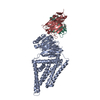 8smmC 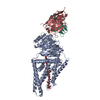 8smnC 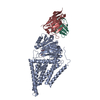 8smpC 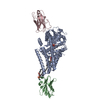 8sndC  8sneC M: map data used to model this data C: citing same article ( |
|---|---|
| Similar structure data | Similarity search - Function & homology  F&H Search F&H Search |
- Links
Links
- Assembly
Assembly
| Deposited unit | 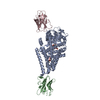
|
|---|---|
| 1 |
|
- Components
Components
-Antibody , 2 types, 2 molecules BC
| #2: Antibody | Mass: 14783.248 Da / Num. of mol.: 1 Source method: isolated from a genetically manipulated source Source: (gene. exp.)   |
|---|---|
| #3: Antibody | Mass: 15184.657 Da / Num. of mol.: 1 Source method: isolated from a genetically manipulated source Source: (gene. exp.)   |
-Protein / Sugars , 2 types, 2 molecules A
| #1: Protein | Mass: 65890.062 Da / Num. of mol.: 1 Source method: isolated from a genetically manipulated source Source: (gene. exp.)  Paramecium bursaria Chlorella virus CZ-2 Paramecium bursaria Chlorella virus CZ-2Gene: CZ-2_118R / Production host:  |
|---|---|
| #4: Polysaccharide | beta-D-glucopyranuronic acid-(1-3)-2-acetamido-2-deoxy-beta-D-glucopyranose Source method: isolated from a genetically manipulated source |
-Non-polymers , 3 types, 4 molecules 




| #5: Chemical | ChemComp-Y01 / | ||
|---|---|---|---|
| #6: Chemical | | #7: Water | ChemComp-HOH / | |
-Details
| Has ligand of interest | Y |
|---|---|
| Has protein modification | Y |
-Experimental details
-Experiment
| Experiment | Method: ELECTRON MICROSCOPY |
|---|---|
| EM experiment | Aggregation state: PARTICLE / 3D reconstruction method: single particle reconstruction |
- Sample preparation
Sample preparation
| Component | Name: Ternary complex of Chlorella virus hyaluronan synthase bound to nanobodies 872 and 886 Type: COMPLEX / Entity ID: #1-#3 / Source: RECOMBINANT |
|---|---|
| Molecular weight | Value: 95.3 kDa/nm / Experimental value: NO |
| Source (natural) | Organism:   Paramecium bursaria Chlorella virus 1 Paramecium bursaria Chlorella virus 1 |
| Source (recombinant) | Organism:  |
| Buffer solution | pH: 7.5 |
| Specimen | Embedding applied: NO / Shadowing applied: NO / Staining applied: NO / Vitrification applied: YES |
| Vitrification | Cryogen name: ETHANE |
- Electron microscopy imaging
Electron microscopy imaging
| Experimental equipment |  Model: Titan Krios / Image courtesy: FEI Company |
|---|---|
| Microscopy | Model: FEI TITAN KRIOS |
| Electron gun | Electron source:  FIELD EMISSION GUN / Accelerating voltage: 300 kV / Illumination mode: FLOOD BEAM FIELD EMISSION GUN / Accelerating voltage: 300 kV / Illumination mode: FLOOD BEAM |
| Electron lens | Mode: BRIGHT FIELD / Nominal magnification: 81000 X / Nominal defocus max: 2000 nm / Nominal defocus min: 1000 nm / Cs: 2.7 mm / C2 aperture diameter: 100 µm |
| Specimen holder | Cryogen: NITROGEN |
| Image recording | Electron dose: 50 e/Å2 / Film or detector model: GATAN K3 (6k x 4k) |
- Processing
Processing
| EM software | Name: PHENIX / Version: 1.20.1_4487: / Category: model refinement | ||||||||||||||||||||||||
|---|---|---|---|---|---|---|---|---|---|---|---|---|---|---|---|---|---|---|---|---|---|---|---|---|---|
| CTF correction | Type: PHASE FLIPPING AND AMPLITUDE CORRECTION | ||||||||||||||||||||||||
| 3D reconstruction | Resolution: 3.2 Å / Resolution method: FSC 0.143 CUT-OFF / Num. of particles: 115974 / Symmetry type: POINT | ||||||||||||||||||||||||
| Refine LS restraints |
|
 Movie
Movie Controller
Controller







 PDBj
PDBj






